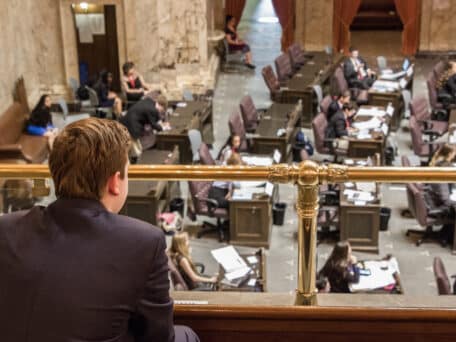Sound Transit officials often point to traffic congestion relief and air quality improvement when arguing on behalf of an ever-expanding light rail system. Specifically, these positive outcomes are trumpeted whenever Sound Transit goes to voters to ask for more of their hard-earned taxpayer dollars. Well, according to new research by the Washington Policy Center, light rail would not actually relieve traffic congestion or improve air quality.
A recent editorial in The Seattle Times penned by Sound Transit officials argues, “Light-rail extensions also drive growth to urban centers where people rely less on cars, further reducing congestion and pollution.” That claim is, in fact, not true. Traffic congestion is expected to increase with or without light rail. The Washington Policy Center,
“Even Sound Transit CEO Joni Earl admits that more light rail will not provide congestion relief. She said, ‘We’ve never said we will reduce congestion.’
“The most recent study on expanding rail to Lynnwood shows she was right. A formal review of the $1.4 to $2.0 billion Lynnwood Link project finds that congestion on urban freeways would remain whether or not light rail is built. The project’s Final Environmental Impact Statement found, ‘Freeway congestion and unreliable travel times would still occur,’ and that, ‘congested conditions would still remain,’no matter what light rail route is chosen.
“Sound Transit’s own projections show the amount people drive 20 years from now would only decrease by 0.28 percent after spending $1.4 to $2.0 billion on building rail to Lynnwood.”
The reality is that commuters choose light rail less than 1 percent of the time. The Washington Policy Center,
“Federal estimates show people in the average household make 9.5 trips per day. Within Sound Transit’s district, that equals 3.9 billion total trips every year. Sound Transit’s total light rail ridership last year was approximately 11 million, or 0.28 percent of all trips people made in the taxing district. The Puget Sound Regional Council estimates that, even after light rail is vastly expanded, light rail would carry less than 1 percent of daily trips by 2040.”
In the Times editorial, Sound Transit officials also claimed that “[light rail] is among the best things we can do to attract more jobs, connect major cities and job centers, and improve the air we breathe.” Their claim is, once again, false. In fact, light rail is among the “least effective and most expensive ways to reduce carbon emissions.” The Washington Policy Center,
“According to Sound Transit’s Lynnwood Link Final Environmental Impact Statement, building the 8.5 mile light rail extension from Northgate to Lynnwood would reduce CO2 emissions by 209 metric tons daily or 76,285 metric tons annually. Using the conservative construction cost estimate of $1.4 billion for Lynnwood Link, that’s a cost of $612 per metric ton of CO2 reduction over 30 years. That does not include the cost to operate the rail line which would drive the cost per reduced metric ton even higher. Further, this analysis does not include the energy involved in building the light rail line, which would reduce the total CO2 reduction achieved by the projects.
“Terapass, a nationally known firm that helps people invest in carbon-reduction projects, charges $13.12 to remove one metric ton of carbon emissions from the atmosphere. Offsetting 76,285 metric tons of CO2 pollution at Terrapass would only cost about one million dollars per year.
“To put it another way, the money Sound Transit officials want to spend on light rail could buy carbon offsets from programs like Terrapass for over one thousand years, improving air quality far beyond the 30 to 50 year lifespan of light rail.”
You can check out the Washington Policy Center’s full policy note here.




